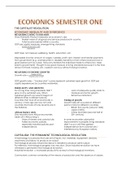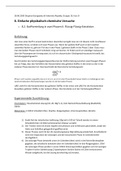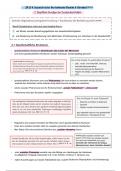ECONOMIC INEQUALITY AND DIVERGENCE
MEASURING LIVING STANDARDS
Gross Domestic Product measures an economy’s size:
- Market value of all goods and services produced in country.
- Total income earned within a country.
GDP per capita measures average living standards
𝑖𝑛𝑐𝑜𝑚𝑒 𝑝𝑒𝑟 𝑝𝑒𝑟𝑠𝑜𝑛 𝑜𝑟 𝐺𝐷𝑃
- 𝑝𝑜𝑝𝑢𝑙𝑎𝑡𝑖𝑜𝑛
GDP does not measure wellbeing, health, education, etc.
Disposable income: amount of wages / salaries, profit, rent, interest and transfer payments
from government [e.g. unemployment / disability benefits] or from others received over a
given period such as a year, minus any transfers the individual made to others [incl. taxes
paid to government]. Thought to be good measure of living standards because it is the max
amount of food, housing, etc. a person can buy without having to borrow.
MEASURING ECONOMIC GROWTH
𝑐ℎ𝑎𝑛𝑔𝑒 𝑖𝑛 𝐺𝐷𝑃
Growth rate = 𝑜𝑟𝑖𝑔𝑖𝑛𝑎𝑙 𝑙𝑒𝑣𝑒𝑙 𝑜𝑓 𝐺𝐷𝑃
GDP growth rates – “hockey-stick” curves represent sustained rapid growth in GDP per
capita experienced by countries worldwide.
INEQUALITY AND GROWTH
For a long time, living standards didn’t - Lack of adequate quality data to
grow in any sustained way. When measure economic growth.
sustained growth occurred it began at - Extractive institutions.
different times in different places.
Countries that took off economically a Timing of growth
century / more ago are now rich and Growth take-off occurred at different
countries that took off only recently are in points in time for different countries:
the flatlands. - Britain first country [around 1650].
- Japan [1870].
African hockey stick - China and India [second half of
Only recently have African economies 20th century].
taken off [“Africa rising”]:
- Years of slavery and colonial rule. In some economies substantial
- Failed economic policies, improvements in peoples living standards
especially industrial policies post- didn’t occur until they gained
independence. independence from colonial rule /
interference by European nations.
CAPITALISM: THE PERMANENT TECHNOLOGICAL REVOLUTION
A technology is a process that uses set of inputs, incl. materials, equipment, devices,
machinery and labour to produce an output.
Technological process means less labour is needed to produce same output.
For millennia, technological progress was very slow. Since industrial revolution we have
witnessed a permanent technological revolution.
Industrial revolution increased productivity as result of technological inventions.
Communism: common ownership of the means of production and the absence of classes.
,Socialism: many variants, defined between communism and capitalism. Focus on socializing
production, more so on socializing consumption [free access to goods].
Capitalism ≠ democracy.
Democracy: a political system defined by individual rights that allow the people to rule.
DEFINING CAPITALISM
An economic system [a way of organizing the production and distribution of goods and
services in an entire economy].
Characterized by a new combination of institutions built around:
- Private property [people owning things].
- Markets:
o A way of connecting people who may mutually benefit by exchanging goods
and services through a process of buying and selling.
- Firms [businesses]:
o Way of organizing production w. characteristics:
One / more individuals own a set of capital goods that are used in
production.
Pay wages and salaries to employees.
Direct the employees [through managers they also employ] in
production of goods and services.
Goods and services are property of owners.
Owners sell goods and services on markets w. intention of making
profit.
Capitalist economies rely on non-capitalist institutions:
- Families.
- Government.
In capitalist economy, important type of private property is equipment, buildings, and other
durable inputs used in producing goods and services – called capital goods.
Labour market – firm owners offer jobs at wages / salaries that are high enough to attract
people who are looking for work.
Capitalism as an economic system
Markets and private property are essential parts of how firms function for two reasons:
- Inputs and outputs are private property.
- Firms use markets to sell outputs.
How capitalism improved living standards
Specialization:
- Growth of firms and expansion of markets allowed for an unprecedented division of
labour.
Technology:
- Firms competing w. one another had strong incentives to adopt and develop new
and more productive technologies.
These ideas usually attributed to Adam Smith:
- Considered by many to be founder of modern economics.
Gains from specialization
People are more productive when they focus on a limited range of activities due to:
- Difference in ability.
- Learning by doing.
- Economies of scale [producing a large number of units of some goods is often more
cost effective than producing a smaller number].
People only specialize if they can acquire the other goods they need.
,Specialization [/ the division of labour] raises question of how goods are distributed among
people.
Market management
Markets generate unintended cooperation on global scale.
Absolute advantage
A person / country has an absolute in production of a good if the inputs it uses to produce
this good are less than some other person or country.
Comparative advantage
A person / country has comparative advantage in production of a particular good, if cost of
producing an additional unit of that good relative to the cost of producing another good is
lower than another person / country’s cost to produce the same two goods.
Capitalism, causation and history’s hockey sticks
Proving causation is difficult in economies because economy is complex and generally can’t
perform large scale experiments on entire populations.
Capitalism emerged in Europe about the same time as the Enlightenment and the expansion
of free speech and democracy.
Divergence in Wealth of Nations
Capitalism fails to raise living standards when:
- Private property is not secure.
- Markets are not competitive.
- Firms are owned / managed by people w. government connections / privileged
birth.
- Political conditions.
Capitalism can be a dynamic economic system when it combines:
- Private incentives for cost-reducing innovation.
- Firms led by those w. proven ability to produce goods at low cost.
- Public policy supporting these conditions.
- A stable society, biophysical environment and resource base.
ECONOMICS AND ECONOMY
Economics: study of how people interact w. each other and w. natural surroundings in
producing their livelihoods and how this changes over time. Therefore about:
- How we come to acquire things that make up our livelihood.
- How we interact w. each other.
- How we interact w. natural enviro.
- How these things change over time.
TECHNOLOGY, POPULATION AND GROWTH
HISTORY’S HOCKEY STICK
Industrial revolution dramatically increased ability of families to provide for basic
average living standards in many necessities.
countries. Most people were at near Sustained and dramatic increase in
subsistence levels of income [earned just average incomes following industrial
enough to stay alive]. If incomes dropped revolution effectively removed constraint
further, mortality increased. Population on population growth.
levels were constrained [held back] by
POPULATION AND INCOME: “MALTHUSIAN ECONOMICS”
Malthusian economics asks: what is relationship between population levels and income?
The “Malthusian Trap”:
- Income growth would lead to population growth.
, - In turn, this would lead to falling income levels as more people put pressure on
available resources.
- Economic model was wrong.
Malthusian model
Model abstracts from most aspects of food production and makes 2 key assumptions:
- Production function has a diminishing average product of labour.
𝑡𝑜𝑡𝑎𝑙 𝑝𝑟𝑜𝑑𝑢𝑐𝑡
o Average product of labour = 𝑛𝑢𝑚𝑏𝑒𝑟 𝑜𝑓 𝑓𝑎𝑟𝑚𝑒𝑟𝑠
- Population increases when average product exceeds subsistence.
Model assumes labour and fixed quantity of land as production factors.
His argument states that as number of farmers increased, the average product would
decrease. This is the diminishing average product of labour key to his argument.
His second argument is that as living standards increase, population growth would increase
and visa versa.
His model results in an equilibrium in which there is an income level just sufficient to allow a
subsistence level of consumption. Here, the size of the population and income level of
people stay constant.
Malthus in long run, an increase in productivity will result in larger population but not higher
wages.
Why the average product diminishes
- More labour is devoted to a fixed quantity of land.
- Inferior land is brought into cultivation.
Malthusian economics
Malthus argued that average product of labour declines w. population.
Also argued the population increases when average product exceeds subsistence.
Technological improvements temporarily increase the average product, but this then
increases population until average product falls back to subsistence levels.
Effect of technological progress
Equilibrium: subsistence incomes prevail, and population is consistent improvement in
technology average output per farmer rises farmers income rises population rises
less land per farmer average output per farmer falls farmer’s incomes fall equilibrium:
subsistence incomes prevail and population constant at higher level.
Revising Malthus’ Law
Three conditions are required to stay in Malthusian trap:
- Diminishing average product of labour.
- Rising population in response to increases in wages.
- Absence of improvements in technology to offset the diminishing average product of
labour.
The permanent technological revolution meant that third condition no longer holds and
explains why Britain was able to escape Malthusian trap.
Escaping Malthusian trap
Britain was stuck in Malthusian trap from 1280 – 1600 and again from 1740 – 1800.
Britain escaped the Malthusian trap about 1800 because:
- Average product of labour grew faster than population.
- Improvements in sanitation and medicine increased health in 19th century.
- Contraception and family planning slowed population growth in 20th century.
WHY INDUSTRIAL REVOLUTION FIRST OCCURDED IN BRITIAN
Different opinions:
- Political systems encouraged innovation rather than stability.
- Culture of frugality and hard work.











